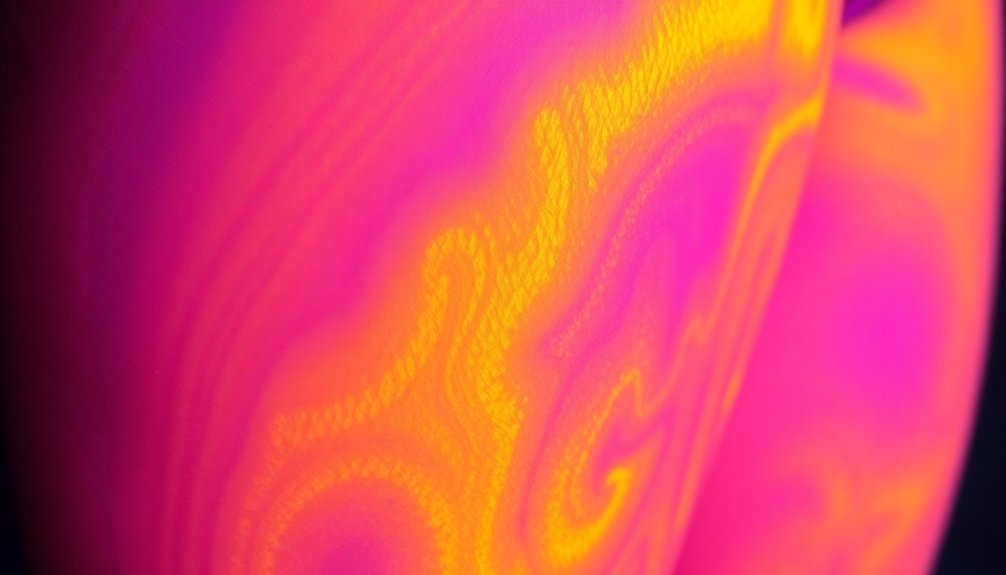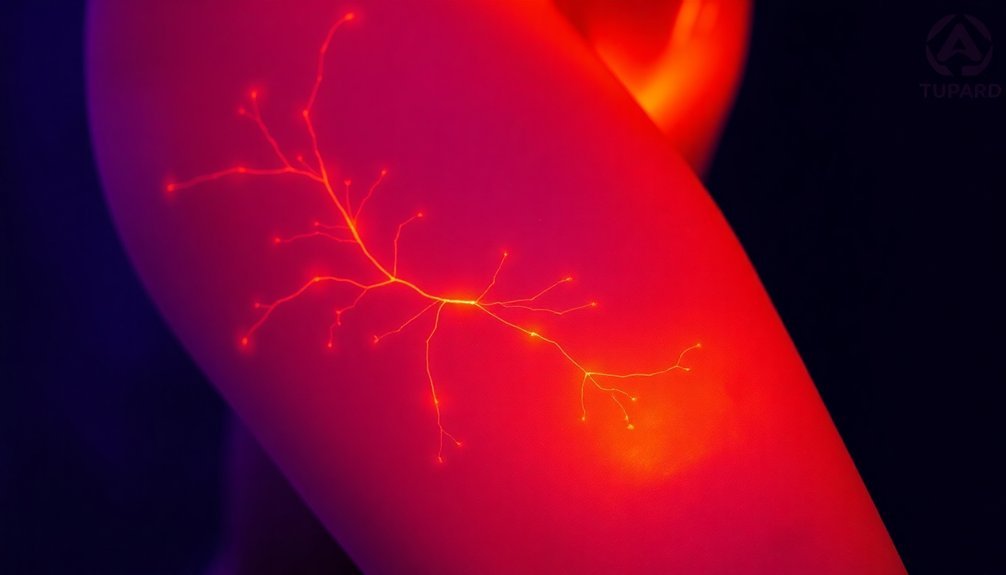Infrared therapy tackles your cellulite through three powerful mechanisms. First, it penetrates deep into your tissue to break down stubborn fat cells, triggering lipolysis and helping your body release stored fatty acids. Second, it boosts your blood circulation, which enhances oxygen flow and activates your body's natural detoxification processes to flush out toxins. Third, it stimulates collagen production by activating fibroblasts, which helps restore your skin's elasticity and firmness for a smoother appearance. When you understand how these mechanisms work together, you'll discover why infrared therapy has become a go-to solution for cellulite reduction.
Deep Tissue Fat Breakdown

When infrared light penetrates the skin's surface, it triggers a series of biological responses that lead to deep tissue fat breakdown. The infrared light reaches deep into your subcutaneous layers, where it heats fat cells and surrounding tissues. This targeted heating stimulates fat cells to release their stored fatty acids, initiating the process of lipolysis. Regular treatments can help achieve consistent fat reduction over time.
You'll experience enhanced metabolic activity as your body temperature rises, causing you to burn more calories naturally. The heat also improves your circulation, delivering more oxygen and nutrients to the treated areas.
This increased blood flow helps transport broken-down fat cells out of your system while supporting the natural detoxification process.
As your fat cells break down and shrink, you'll notice a reduction in circumference around treated areas. The process doesn't just target fat – it also boosts collagen production, which is essential for maintaining skin elasticity and firmness.
This dual action helps prevent loose skin that can sometimes occur with fat loss. Your body continues to process and eliminate the released fat through natural metabolic pathways, primarily through breathing and your lymphatic system.
Blood Flow and Detoxification
Boosting blood flow through infrared therapy creates a powerful detoxification effect in your body. As infrared light penetrates up to 7.5 cm beneath your skin, it heats fat cells and stimulates circulation, delivering essential oxygen and nutrients to targeted areas.
This enhanced blood flow doesn't just nourish your skin – it kickstarts an extensive detoxification process. The process helps break down stored fat and release its components like water and carbon dioxide.
You'll experience increased sweating, which helps your body eliminate fat-soluble toxins, including heavy metals and bisphenol A. The therapy also activates your lymphatic system, reducing fluid retention and swelling while removing waste products that contribute to cellulite formation.
As your circulation improves, you'll notice reduced toxin retention in fat cells, leading to smoother skin appearance.
When you combine infrared therapy with other treatments like massage or exercise, you'll maximize its benefits. Your metabolism will increase, supporting faster fat breakdown, while the improved lymphatic drainage reduces circumference in problem areas.
For best results, pair your infrared sessions with a balanced diet and regular exercise – this holistic approach guarantees you're targeting cellulite from multiple angles while supporting your body's natural detoxification processes.
Collagen Production and Repair

Infrared therapy's impact extends beyond detoxification to trigger powerful collagen-building effects in your skin. When you expose your body to red and near-infrared light, it penetrates deeply into your dermis, activating fibroblasts that are responsible for producing essential Type I and III collagen.
This increased collagen production helps restore your skin's elasticity and firmness, directly targeting the structural causes of cellulite. The therapy promotes fibroblast differentiation into myofibroblasts, leading to enhanced extracellular matrix production.
You'll benefit from the therapy's ability to stimulate your cells' mitochondria, boosting ATP production and enhancing collagen synthesis. The light waves don't just promote new collagen formation – they also help prevent collagen degradation, maintaining your skin's improved texture over time.
When combined with other treatments like massage or radiofrequency, you'll see even better results in reducing cellulite's appearance.
Clinical studies have consistently shown that regular infrared therapy sessions can substantially increase your skin's collagen density. The treatment works by improving collagen crosslinks and boosting elastin production, giving you firmer, healthier-looking skin.
You'll find this non-invasive approach particularly effective when used consistently as part of your anti-cellulite routine.
Frequently Asked Questions
How Long Does Each Infrared Therapy Session Typically Last?
Your infrared therapy sessions will typically last 10-20 minutes, with ideal results achieved in 15-20 minute sessions. You'll want to maintain consistency by scheduling 3-5 sessions per week for best outcomes.
Can I Combine Infrared Therapy With Regular Exercise for Better Results?
Yes, you can definitely combine infrared therapy with exercise for enhanced results. You'll get better outcomes by mixing 30-45 minute infrared sessions with regular workouts like cardio and strength training 2-4 times weekly.
How Many Sessions Are Needed Before Seeing Visible Cellulite Reduction?
You'll typically start seeing visible results after 3-4 sessions, but you'll need 6-8 weekly treatments for the best cellulite reduction. Remember that everyone's response varies, so be patient with your progress.
Are There Any Skin Conditions That Prevent Using Infrared Therapy?
If you have dermatitis, eczema, melasma, skin cancer, or recent burns, you shouldn't use infrared therapy. You'll also need to avoid it if you have photosensitivity or impaired thermal sensations in your skin.
What Should I Wear During an Infrared Therapy Session?
You'll want to wear loose, breathable clothes made of natural fabrics like cotton or bamboo. Skip synthetic materials and remove jewelry. Choose comfortable undergarments without metal components. Don't forget to tie back your hair.
In Summary
You'll find infrared therapy to be an effective natural solution for reducing cellulite through three key mechanisms. It breaks down stubborn fat deposits, increases blood circulation to flush out toxins, and stimulates collagen production to improve skin texture. Whether you're using an infrared sauna or targeted treatments, you can expect gradual improvements in those bothersome dimpled areas with consistent sessions.





Leave a Reply